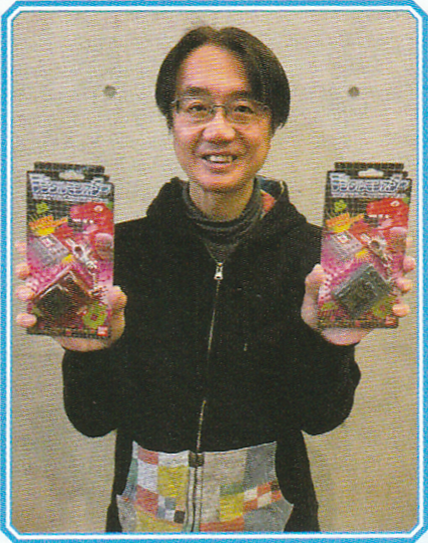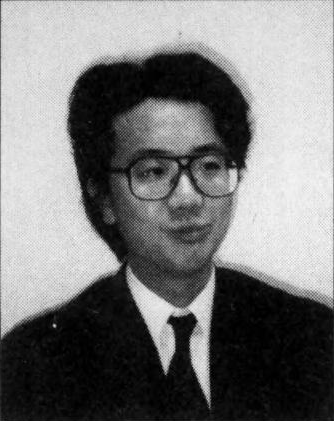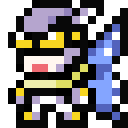
Name: Horimura Ayumu (堀村有由文, ほりむら あゆむ)
Current Status: Retired1
General History: An Art College graduate, he worked as a part of Bandai’s “First Toy Divison” in charge of planning and producing toys targeted at boys, in particular Shueisha’s character products. He has 20 patents on his name that he developed while working on Bandai. Later in life, he became the producer in charge of One Piece products. He is now retired.
Digimon History: As a developer in Bandai’s 1st Toy Division, he was called by Takeichi Hongo, who was the head of the department back then, to work on a new product, Tamagotchi. Tamagotchi had an intriguing history, as although it was a toy targeted at girls, it was being developed by the Boy Toys division.2
Although there were initial challenges in getting Tamagotchi into sale, a test sale was made on October 10, 1996, with 1,000 units selling out in just over two days, showing great desire for the toys, so much so that Bandai was unable to keep up with the demand, which resulted in many companies creating copies.3
After seeing the success of the marketing test of Tamagotchi, Ayumu Horimura wondered if a similar toy, but made for toys could do well, so he started thinking of “Otokotchi”, the “Tamagotchi for Boys”. The development was made mainly by Ayumu Horimura alongside Kenji Watanabe and Makoto Kitagawara from WiZ, although there was an oversight by their bosses, Akihiro Yokoi and Takeichi Hongo.
The development evolved over the months and the project became called by many names, “Otokochi”, “Fighting Tamagotchi”, and “Capsule Zaurus”, until it finally became “Digital Monster or”, “Digimon” for short.
Originally the plan was to just be another Tamagotchi side-project, like many others that would be done it was basically just Tamagotchi with a unique gimmick and scenario, no plans to make this its own franchise with many sequels. Ayumu Horimura had a different idea and expected to see Digimon grow on its own, becoming a great Media-mix franchise.
He used his contacts with Shueisha to get an opportunity to feature Digimon in their magazines, such as the Weekly Shonen Jump, the Monthly V-Jump, and the special Akamaru Jump, in which there would be a one-shot manga. The objective was to have Digimon follow the tradition of many popular Jump series.
① Serialization in the Jump magazines
② Become a hot topic
③ Grow enough to have an Anime adaptation
④ Spread out into Media-mix
This was the golden line for popular Shueisha characters and Horimura thought that Digimon had what was needed to follow in the footsteps of success. He was eventually proven right and Digimon quickly became a success, and so a brand-new version “Digital Monster Ver.2” started development.
Around that time he had requested one of the developers at the 1st Toy Department to start working on Digimon toys, but another developer who was looking at their work wasn’t happy with this, thinking much more could be done with Digimon, and started to guide his kōhai on how to make good toys.4
With the success of “Digital Monster” a Nationwide Tour in which the Weekly Jump character “Digimonkey” would fight children and deliver gifts was planned and Horimura was called to appear, but he got very sick and couldn’t appear.
In the hospital, he needed someone to take over Digimon and Tamagotchi while he was sick, so he decided to ask the other developer who decided to help, which was Kensuke Ota, more well-known as Volcano Ota. According to Horimura, he initially was planning to have Ota in charge of making Digimon’s toys, so he was happy when he volunteered to help their kōhai.
Ota started working in the middle of the development of “Digital Monster Ver.2” and “Tamagotchi Osutchi and Mesutchi”. When Horimura got better and returned, Ota was already in love with Digimon and didn’t want to give the series back to Horimura. Even though Ota thought this was a rude request to make, Horimura was already thinking to do that, and gave Ota the actual role of Digimon planner and producer, while he returned to Tamagotchi.
After years without working directly on the “Digimon” series, he was interviewed for the book “Digital Monster 25th Anniversary Book –Digimon Device & Dot History–” in which he revealed secrets about the development of the first Digital Monster toy.
Gallery





Pingback: Digimon Staff Archive – Digital World Archive